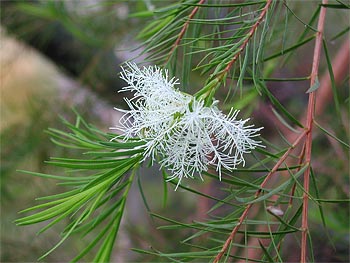Introduction

Flower of Melaleuca alternifolia
Tea tree oil, or Melaleuca oil, is an essential oil taken from the leaves of the Melaleuca alternifolia, which is native to Southeast Queensland and the Northeast coast of New South Wales, Australia.
The name tea tree is used for a number of plants, mostly from Australia and New Zealand, from the family Myrtaceae, related to the myrtle. Although tea tree oil normally is extracted from Melaleuca alternifolia commercially, it can also be extracted from Melaleuca dissitiflora and Melaleuca linariifolia. The use of the name probably originated from Captain Cook's description of one of these shrubs, that he used to make an infusion, to drink in place of tea.
Complementary and alternative medicines such as tea tree ( Melaleuca ) oil have become increasingly popular in recent decades. This essential oil has been used for almost 100 years in Australia but is now available worldwide both as neat oil and as an active component in an array of products. The primary uses of tea tree oil have historically capitalized on the antiseptic and anti-inflammatory actions of the oil.
This review summarizes recent developments in our understanding of the antimicrobial and anti-inflammatory activities of the oil and its components, as well as clinical efficacy. The toxicity of the oil is briefly discussed.
Composition
Tea tree oil is composed of terpene hydrocarbons, mainly monoterpenes, sesquiterpenes, and their associated alcohols. Terpenes are volatile, aromatic hydrocarbons and may be considered polymers of isoprene, which has the formula C 5 H 8 . The seminal paper by Brophy and colleagues examined over 800 tea tree oil samples by gas chromatography and gas chromatography-mass spectrometry and reported approximately 100 components and their ranges of concentrations (see this table). Among over 98 compounds contained in the oil, terpinen-4-ol is responsible for most of the antimicrobial activity (Terpinen-4-ol, the main component of the essential oil of Melaleuca alternifolia (tea tree oil), suppresses inflammatory mediator production by activated human monocytes, 2000).

Synthesis of terpinen-4-ol
Medical use
Antimicrobial activity
From the early 1990s onwards, many reports describing the antimicrobial activity of tea tree oil appeared in the scientific literature. Although there was still a degree of discrepancy between the methods used in the different studies, the MICs reported were often relatively similar. A broad range of bacteria have now been tested for their susceptibilities to tea tree oil, and some of the published susceptibility data are summarized in this table. While most bacteria are susceptible to tea tree oil at concentrations of 1.0% or less, MICs in excess of 2% have been reported for organisms such as commensal skin staphylococci and micrococci, Enterococcus faecalis, and Pseudomonas aeruginosa. Tea tree oil is for the most part bactericidal in nature, although it may be bacteriostatic at lower concentrations (Melaleuca alternifolia (tea tree) oil: a review of antimicrobial and other medicinal properties, 2006).
The activity of tea tree oil against antibiotic-resistant bacteria has attracted considerable interest, with methicillin-resistant Staphylococcus aureus (MRSA) receiving the most attention thus far. In vitro studies revealed that treatment with tea tree oil possesses similar rates of eradication when compared to that with mupirocin (MRSA colonisation (eradicating colonisation in people without active/invasive infection), 2011).
Acne treatment
The evidence for its efficacy in the treatment of various skin conditions was only anecdotal until some recente studies (like A comparative study of tea-tree oil versus benzoylperoxide in the treatment of acne, 1990) proved that applying a 5% tea tree oil appears to be as effective as 5% benzoyl peroxide (Oxy-5, Benzac AC, and others), by reducing the number of inflamed and non-inflamed lesions (open and closed comedones), although the onset of action in the case of tea tree oil was slower. Encouragingly, fewer side effects were experienced by patients treated with tea tree oil, for example it seems to be less irritating to facial skin.
Anti-inflammatory activity
The water-soluble components of tea tree oil can suppress pro-inflammatory mediator production by activated human monocytes. Numerous recent studies now support the evidence attributing anti-inflammatory activity to tea tree oil. In vitro work over the last decade has demonstrated that tea tree oil affects a range of immune responses, both in vitro and in vivo. For example, the water-soluble components of tea tree oil can inhibit the lipopolysaccharide-induced production of the inflammatory mediators tumor necrosis factor alpha (TNF-α), interleukin-1β (IL-1β), and IL-10 by human peripheral blood monocytes by approximately 50% and that of prostaglandin E2 by about 30% after 40 h (Melaleuca alternifolia (tea tree) oil: a review of antimicrobial and other medicinal properties, 2006).
Controversies and conclusions
A wealth of in vitro data seems to support the long-held beliefs that tea tree oil has antimicrobial and anti-inflammatory properties. The abovementioned tea tree oil benefits notwithstanding, some critics have also appeared in the recent literature. For instance, a 2005 review states that there is insufficient evidence to recommend routine use for this purpose in a clinical setting (Is tea tree oil effective at eradicating MRSA colonization? A review, 2005).
Other authors believe that despite some progress, there is still a lack of clinical evidence demonstrating efficacy against bacterial, fungal, or viral infections. Larger randomized clinical trials are now required to cement a place for tea tree oil as a topical medicinal agent (Terpinen-4-ol, the main component of the essential oil of Melaleuca alternifolia (tea tree oil), suppresses inflammatory mediator production by activated human monocytes, 2000).
Furthermore, despite the progress in characterizing the antimicrobial and anti-inflammatory properties of tea tree oil, less work has been done on the safety and toxicity of the oil. The rationale for continued use of the oil rests largely on the apparently safe use of the oil for almost 80 years. Anecdotal evidence over this time suggests that topical use is safe and that adverse events are minor, self-limiting, and infrequent (Melaleuca alternifolia (tea tree) oil: a review of antimicrobial and other medicinal properties, 2006). However, when swallowed, the tea tree oil is toxic.
Martina Mazzoli, Francesca Toja